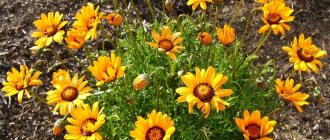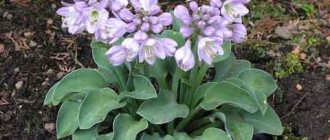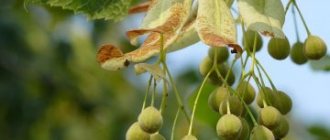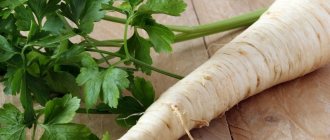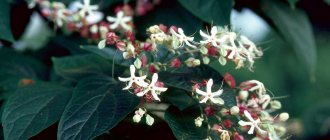Description and characteristics of asparagus pinnate
Asparagus pinnate is classified as a perennial evergreen. The stems of the shrub are thin and curly. If you build supports for the plant, it can grow upward, but if this is not done, the stems will hang down like a vine or cascade down.
Crescent asparagus at home
The shrub belongs to the Asparagus family. Externally, the shoots of the plant resemble bird feathers. The stems grow up to 150 cm in height and are highly branched. Flowers are formed mainly in the axils of leaves. They are very small racemose or solitary.
For your information! After flowering, the plant produces berries containing seeds.
Common varieties
The genus Asparagus includes more than 300 species. They are all similar in shape. The main indoor subspecies include:
- Meyer is a small shrub that reaches a height of no more than 50 cm. The structure is branched;
- Crescent is a subshrub with climbing stems. With proper care and optimal conditions, it can grow up to 7 m;
- Sprenger. The shrub reaches a height of up to 50 cm. The stems of the plant are branched. It blooms with snow-white miniature flowers, after which oval burgundy fruits appear on the bush.
Medicinal properties
Asparagus Plumosus, also known as pinnate, like all other varieties of this shrub, is rich in mineral salts, flavonoids, vitamins and amino acids. In Chinese medicine, this plant has been used for a long time to treat many diseases.
Dried roots are used for therapeutic purposes. They have antibacterial, antiseptic, anti-inflammatory and diuretic effects. They also treat pulmonary and gastric diseases.
For your information! As a result of scientific research, it was concluded that asparagus contains antitumor substances.
Among other things, the root of this plant is used to treat diabetes, migraines, the nervous system, and multiple sclerosis. The roots help cleanse the human body of toxins.
Briefly about the history of appearance
Asparagus plumosus appeared more than three thousand years ago. In ancient times, this particular plant was considered divine. The Egyptians were sure that asparagus had a direct effect on the continuation of the human race.
Description of the plant
Meyer's asparagus is a bushy plant whose stems are covered with fluff with green thin leaves shaped like needles. Grows up to 50 centimeters in height. The variety belongs to the Asparagus genus.
In the center of the bush you can see smooth, flexible, light green, woody stems. Many short lateral branches covered with thin cladodes extend from them. This type of plant makes it look like the tied tails of foxes. Meyer's asparagus has scaly foliage.
The bush blooms mainly in summer. It blooms with axillary, yellowish-white, bell-shaped flowers reaching a length of 5 millimeters. After flowering, bright red berries are formed in the shape of a ball, 6–10 millimeters in diameter.
Features of flower care at home
Meyer's asparagus - home care
When growing shrubs at home, no special manipulations are required during the care process. All recommendations are quite simple and understandable. The most important thing is to protect the plant from hypothermia and drafts. It is also necessary to monitor the volume of the pot, since as the shrub develops it greatly increases in size. As soon as there is little space for a flower, it must be replanted immediately.
The rules for caring for asparagus pinnate are simple and clear, so even a novice gardener can handle it.
Temperature
In order for the flower to feel comfortable, it is necessary to maintain a temperature in the room of no more than 25 ° C in spring and summer. In winter it should vary from 14 °C to 16 °C.
Note! You should not allow too high temperatures in winter, as this will cause the shrub to look unpresentable and eventually wither.
Lighting
When growing asparagus pinnate at home, care should include proper lighting. Since the flower loves light very much, it is best placed on windowsills on the east or west side. At the same time, it is strictly forbidden to allow direct sunlight to fall on the bush. It is recommended to expose the flower to the air only in the warm season.
Watering
The shrub loves moisture very much, so it needs to be watered regularly. In the warm season, watering must be done at least three times a week. When cold weather sets in, the number of water procedures is reduced. It is important not to allow the soil to dry out during this period of time.
For your information! Asparagus loves watering at the root.
Spraying
In addition to regular moistening, it is recommended to systematically spray the plant with a small spray bottle. This helps rid it of dust and gives the flower a vibrant look. For spraying, it is recommended to use settled water at room temperature.
Humidity
Wild asparagus prefers places with high levels of humidity. These are the conditions for development that need to be created at home. To create an optimal humidity level, you can install ionizers or systematically spray the flower.
Soil and fertilizing
When growing a plant at home, it is recommended to feed it twice a year - in spring and summer. All-purpose fertilizers are best suited for this. For planting, experts advise using a mixture of turf, sand, peat and leaf soil.
Properties of asparagus - harm and benefit
Useful properties of asparagus
Asparagus in the country is not only a delicious product, but also a source of vitamins K, A, C, E, PP, group B, as well as folic acid, dietary fiber, copper, sodium, iron, phosphorus, magnesium, selenium, potassium, manganese and other elements.
What are the benefits of asparagus? This is an ideal, low-calorie product for fasting days. The substances contained in asparagus form connective tissue, strengthen bones, take part in the hematopoietic process, and help the functioning of the kidneys, liver and heart. Due to the folic acid content in asparagus, it becomes an indispensable product for pregnant women.
For patients who have had a heart attack, an asparagus diet is recommended, since the asparagine contained in the product dilates blood vessels, stimulates the work of the heart muscle and lowers blood pressure. The benefit of asparagus is also in the coumarins it contains, which stimulate cardiac activity, cleanse the blood and prevent the formation of blood clots in blood vessels.
- Red currant: cultivation, types and varieties
The beneficial properties of asparagus stimulate processes that rid the body of waste and toxins - phosphates, chlorides and urea. They have a tonic effect on the bladder, kidneys and the entire excretory system.
Asparagus is an excellent cosmetic product: its juice cleanses, nourishes and softens the skin, and also removes calluses and small warts.
Asparagus - contraindications
As much as the healing properties of asparagus are indisputable, the evidence about its harm is equally contradictory and dubious. They claim that with long-term consumption of asparagus, oxalic acid salts accumulate in the body, and this, supposedly, can, if there is a genetic predisposition to this, provoke urolithiasis.
Other experts believe that asparagus, being a diuretic, prevents urolithiasis. In addition, the saponin found in asparagus can irritate the gastric and intestinal mucosa in patients with exacerbation of gastrointestinal diseases. Asparagus is not recommended for articular rheumatism, cystitis, prostatitis and individual intolerance to the product.
How does pinnate asparagus reproduce?
The cobweb, as the flower is popularly called, reproduces by seeds, cuttings and rhizomes. To propagate a flower by seeds, you need to purchase them from a specialized store. The simplest method of propagation is division of the rhizome.
Germination of seeds
If you plan to propagate the flower by seeds, then for this purpose the planting material must first be sown in moist soil in the winter until March. The pot with seeds should be placed in a room with an air temperature ranging from 21 ° C to 22 ° C. Seeds need to be systematically sprayed and ventilated. The first shoots appear in about a month. At the beginning of June, the sprouts are transplanted into individual pots.
Rooting cuttings
The cutting process is considered the most difficult method of propagation, since the plant takes root very poorly. For such propagation, it is important to choose the right healthy and strong shoots, cut cuttings from them, and then place them in prepared soil. Then the cuttings need to be placed in a warm room, systematically moistened and ventilated, waiting for rooting.
Rhizome division
The shrub can be propagated by dividing the rhizomes. To do this, during transplantation, you need to divide the plant into several parts and plant each in a separate pot.
How does an asparagus bush divide?
Methods for propagating asparagus
Asparagus Meyer variety is grown from seeds, using cuttings and dividing the rhizome. Each method of reproduction has its own nuances.
Cuttings
In the spring, Meyer's asparagus is propagated using cuttings. Cut cuttings 10 centimeters long from a healthy bush. Plant them in the sand so they can take root. Place the container with twigs in a room with good lighting and an air temperature of 22 degrees. Cover with film.
Ventilate and lightly water the sand daily. After a month and a half, the cuttings will take root and can be planted in separate containers filled with special soil.
Possible problems in cultivation and diseases
Asparagus pinnate is a plant with good immunity, so it is not afraid of most diseases and pests. Problems arise mainly as a result of improper care. In such cases, the bush may be affected by aphids, spider mites or thrips. When they appear, you need to cut off the affected areas and rinse the stems with warm water.
Stems may fall and turn yellow as a result of the plant being in unfavorable conditions. High temperatures have a detrimental effect on it.
Signs and superstitions
Not only for its exotic and unusual appearance, asparagus is loved by flower growers. The plant is believed to have magical properties. Many claim that it can neutralize the negative energy in the room, defuse the situation, extinguish conflicts and relieve tension after a hard day.
Despite many positive aspects, there is also an unpleasant belief. It has long been believed that if asparagus suddenly dies for no apparent reason, then a similar fate will soon befall someone living in the apartment.
Asparagus pinnate is rightfully considered an amazing and beautiful plant. The flower has long attracted the attention of both experienced and novice gardeners. Moreover, it is very easy to care for it. It is enough to follow the minimum rules, and the shrub will delight you with an attractive and healthy appearance for many years.
Recommendations
Considering that asparagus is just beginning to take root in our gardens and is gaining popularity as a valuable vegetable crop, many are having difficulty cultivating this exotic vegetable.
The easiest way to grow asparagus is by sowing seeds directly into open ground. But this method is the least effective. The seeds have a hard shell and therefore require constantly moist soil and attention. Since plants require light, warmth, and moisture, it is difficult to achieve such favorable conditions in the spring.
Seeds take three or more weeks to germinate, and the young seedlings that develop also grow slowly. Very often, seedlings are exposed to frost, and the plant does not tolerate frost on the soil.
Growing asparagus from seed does require patience. However, like many things in life, patience brings rewards. Asparagus plants are either male or female.
Female plants produce berries; Male plants do not waste energy on berries, so they can be three times more productive than female plants. For this reason, it is preferable to grow male asparagus plants.

